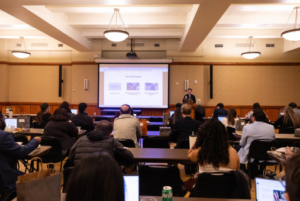April 1, 2025 | Artificial Intelligence, ISOJ2025
Workshop guides journalists on how to leverage Google’s artificial intelligence tools for more efficient reporting
Haga clic aquí para leer este artículo en español.
Artificial intelligence is on the rise, and newsrooms around the world are grappling with feelings of apprehension at the risk of compromising their journalistic integrity. However, Google’s AI tools are evoking curiosity among many journalists, leaving them to wonder if AI can enhance journalists’ work instead of replacing it, and if so, how?

“Who used Google Search today?” Iain Christie asked a room of journalists attending a lunchtime workshop at the 26th International Symposium on Online Journalism (ISOJ). The workshop was led by Christie, a trainer at Google News Initiative, a team that collaborates with journalists to help global newsrooms flourish.
“While the shift to AI may feel kind of sudden to some, we’ve been applying it to Google Products for quite some time,” Christie said. “In fact, AI is already integral to a lot of the products you use, probably every single day.”
Google has welcomed artificial intelligence with open arms, most notably through Google Lens, Google Maps and Gmail. Google’s AI tools don’t end there, Google also hosts AI Overviews, Gemini, Fact Check Explorer, NotebookLM, Pinpoint and News Consumer Insights.
“Hopefully, in the course of today’s session, I’ll show you how those Google AI tools can make your job as journalists easier,” Christie said.
Christie opened the workshop with a condensed history of Google’s involvement with AI. Google began training neural networks, a core component of AI learning designed to mimic the human brain structure and function, with data in 2012.
Google’s AI follows 3 simple principles: bold innovation; responsible development and deployment; collaborative progress, together.
“We can use generative AI to unlock entirely new questions that search can answer,’ Christie said. “Now think of how transformative Google Search was when it launched, then think of how transformative generative AI can be when applied to Google Search.”
With over 8.5 billion Google searches a day or 99,000 searches per second, there is a huge opportunity to use AI to aid in each and every Google search, he said. When doing a simple Google search, users may have noticed a new feature at the top of the results, AI Overviews.
Certain searches will offer an AI Overview that breaks down the topic into easily digestible summaries, with links to sources where the user can learn more.
“With AI Overviews, people actually use search more. They are more satisfied with the results they get, and they are visiting a greater diversity of websites for help with more complex questions,” Christi said.
Christie then introduced the five tools that he would be going over, beginning with Google’s Gemini, a generative AI chatbot and a “huge deal” at Google due in part to the fact that it powers the other four tools he discussed during the workshop.
“This new era of models represents one of the biggest science and engineering efforts we have ever undertaken as a company,” Christie said. “It’s a big ol’ deal, folks.”
Featured across Google Docs, Sheets and Slides, as well as through Gmail’s smart reply, Gemini aims to help boost productivity in the newsroom by helping users communicate more effectively and visualize more efficiently, he said.
“The Gemini ecosystem represents Google’s most capable AI,’ Christie said.
Fact Check Explorer provides insights into fact-checking topics, people and images. Users can search for previously checked claims and whether they are true or false.

“Researchers at Google and several other fact-checking organizations reviewed over 130,000 fact checks,” Christie said.
But who are the fact-checkers? It’s a network of organizations around the world working to explain why misinformation is false, he said. While AI will summarize the results of a fact checking search, it’s the work of numerous journalists that helps decipher veracity.
NoteBookLM is an AI research and writing tool helping journalists find and summarize insights faster.
“It’s like a personalized AI research assistant that helps you understand the information that matters most to you,” Christie said.
Pinpoint is a research tool designed to help journalists explore, organize and analyze large collections of documents, images and more, using AI search technologies – or in Christie’s words – “find a needle in a haystack.”
“It’s for investigative journalists, it’s for the deep dive. It’s for really getting your hands dirty in a particular subject,” Christie said.
On the second day of ISOJ, Christie took a deeper dive into NotebookLM and Pinpoint and how these particular research tools might help journalists in their work.
*Paisley Porter is a third-year Journalism and Communication & Leadership student at UT Austin. She is currently an intern at KXAN and has previously done coverage for TSTV and ISOJ.
Taller guía a periodistas en el uso de herramientas de IA de Google para informar con mayor eficacia
La inteligencia artificial está en auge, y las salas de redacción de todo el mundo enfrentan sentimientos encontrados ante el riesgo de comprometer su integridad periodística. Sin embargo, las herramientas de IA de Google están despertando la curiosidad de muchos periodistas, llevándolos a preguntarse si la IA puede mejorar su trabajo en lugar de reemplazarlo y, de ser así, ¿cómo?
“¿Quién usó Google Search hoy?” preguntó Iain Christie a una sala llena de periodistas que asistían a un taller durante el almuerzo en el 26º Simposio Internacional de Periodismo Online (ISOJ). El taller fue dirigido por Christie, un instructor de Google News Initiative, un equipo que colabora con periodistas para ayudar a que las salas de redacción de todo el mundo prosperen.
“Aunque el cambio hacia la IA puede parecer repentino para algunos, hemos estado aplicándola en los productos de Google desde hace bastante tiempo”, dijo Christie. “De hecho, la IA ya es parte integral de muchos de los productos que usas, probablemente todos los días”.
Google ha acogido la inteligencia artificial con los brazos abiertos, especialmente a través de Google Lens, Google Maps y Gmail. Pero las herramientas de IA de Google no terminan ahí; la compañía también ofrece AI Overviews, Gemini, Fact Check Explorer, NotebookLM, Pinpoint y News Consumer Insights.
“Espero que, a lo largo de la sesión de hoy, pueda mostrarles cómo estas herramientas de IA de Google pueden hacer más sencillo su trabajo como periodistas”, dijo Christie.
Christie inició el taller con un breve repaso de la historia de la implicación de Google con la IA. Google comenzó a entrenar redes neuronales, un componente clave del aprendizaje de la IA diseñado para imitar la estructura y función del cerebro humano, con datos en 2012.
La IA de Google sigue tres principios simples: innovación audaz; desarrollo y despliegue responsable; progreso colaborativo.
“Podemos usar la IA generativa para desbloquear preguntas completamente nuevas que la búsqueda puede responder”, dijo Christie. “Ahora piensen en lo transformador que fue Google Search cuando se lanzó, luego piensen en lo transformadora que puede ser la IA generativa cuando se aplica a Google Search”.
Con más de 8.5 mil millones de búsquedas en Google al día, o 99.000 búsquedas por segundo, existe una gran oportunidad para usar la IA en cada una de ellas, dijo. Al hacer una búsqueda simple en Google, los usuarios pueden haber notado una nueva función en la parte superior de los resultados, los AI Overviews.
Algunas búsquedas ofrecerán un AI Overview que desglosa el tema en resúmenes fáciles de digerir, con enlaces a fuentes donde el usuario puede aprender más.
“Con AI Overviews, las personas en realidad usan más la búsqueda. Están más satisfechas con los resultados que obtienen y visitan una mayor diversidad de sitios web para obtener ayuda con preguntas más complejas”, dijo Christie.
Christie luego presentó las cinco herramientas que abordaría, comenzando con Gemini de Google, un chatbot de IA generativa y un “gran avance” en Google, en parte debido al hecho de que impulsa las otras cuatro herramientas que discutió durante el taller.
“Esta nueva era de modelos representa uno de los mayores esfuerzos científicos y de ingeniería que hemos emprendido como empresa”, dijo Christie. “Es un gran acontecimiento, amigos”.
Integrado en Google Docs, Sheets y Slides, así como en la función de respuesta inteligente de Gmail, Gemini tiene como objetivo ayudar a aumentar la productividad en las salas de redacción, facilitando la comunicación y optimizando la visualización, dijo.
“El ecosistema de Gemini representa la IA más avanzada de Google”, afirmó Christie.
Fact Check Explorer proporciona información sobre temas, personas e imágenes relacionadas con el fact checking. Los usuarios pueden buscar afirmaciones que ya han sido verificadas y saber si son verdaderas o falsas.
“Los investigadores de Google y varias otras organizaciones de verificación de datos revisaron más de 130.000 verificaciones”, dijo Christie.
¿Pero quiénes son los verificadores? Es una red de organizaciones en todo el mundo que trabajan para explicar por qué la desinformación es falsa, dijo. Si bien la IA resumirá los resultados de una búsqueda de verificación, son numerosos periodistas quienes ayudan a descifrar la veracidad.
NotebookLM es una herramienta de investigación y redacción con IA que ayuda a los periodistas a encontrar y resumir información más rápido.
“Es como un asistente de investigación de IA personalizado que te ayuda a comprender la información que más te importa”, dijo Christie.
Pinpoint es una herramienta de investigación diseñada para ayudar a los periodistas a explorar, organizar y analizar grandes colecciones de documentos, imágenes y más, utilizando tecnologías de búsqueda con IA, o en palabras de Christie, “encontrar una aguja en un pajar”.
“Es para periodistas de investigación, para quienes hacen análisis profundos. Es para ensuciarse realmente las manos con un tema en particular”, dijo Christie.
En el segundo día de ISOJ, Christie profundizó en NotebookLM y Pinpoint y en cómo estas herramientas de investigación en particular podrían ayudar a los periodistas en su trabajo.
*Paisley Porter es estudiante de tercer año de Periodismo y Comunicación & Liderazgo en la Universidad de Texas en Austin. Actualmente es pasante en KXAN y anteriormente ha realizado cobertura para TSTV e ISOJ.

